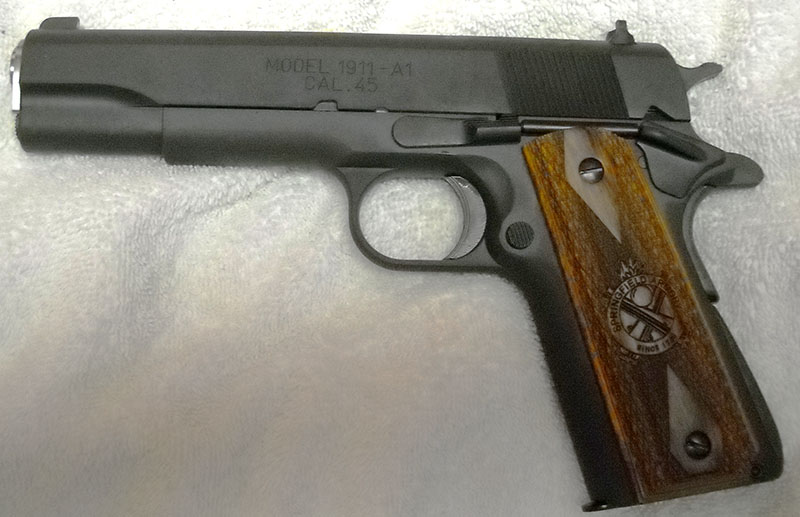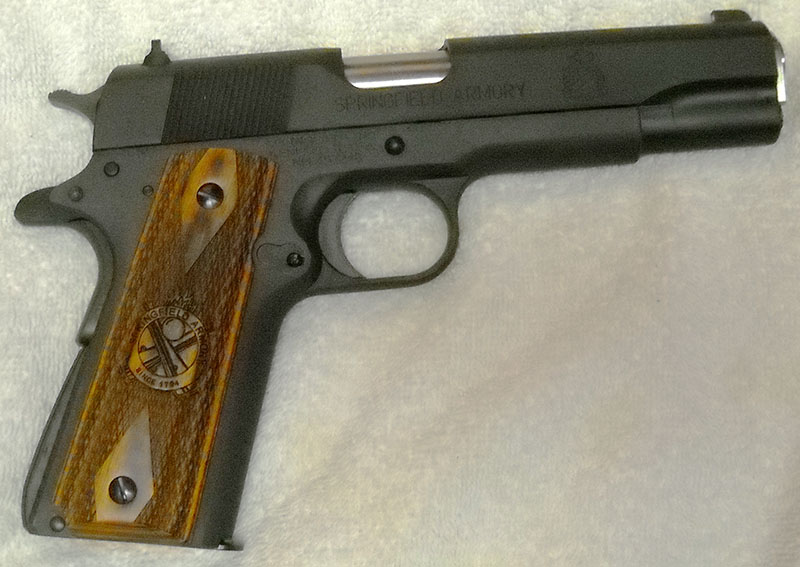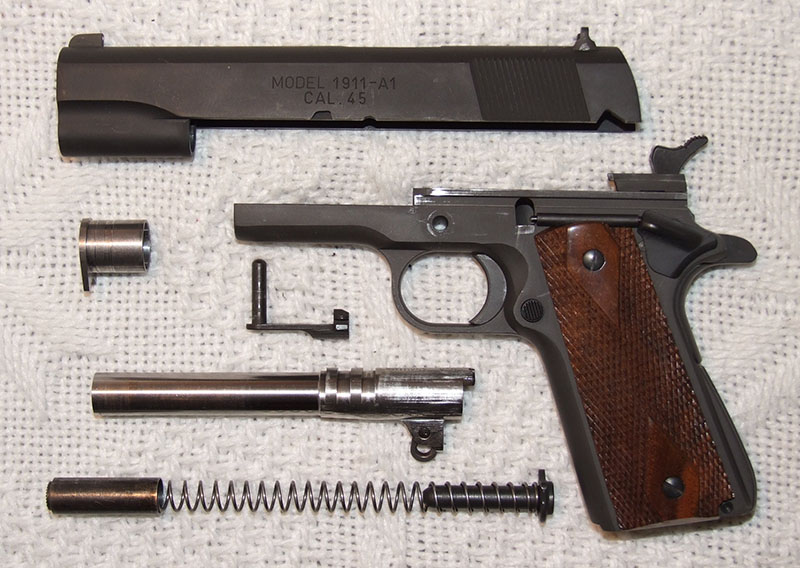LAST EDITED ON Jan-16-17 AT 03:53 PM (EST)
Today's Gun of the Week is, by any measurement I can think of offhand, John Browning's most popular design, and certainly his most famous, although I would argue that it isn't necessarily his best. It is of course the Pistol, Caliber .45, Automatic, M1911A1, which I am required by tribal custom to describe at this point in the review as "venerable".
In its original form, the handgun we now know as the M1911A1 was adopted by the United States Army as the Model of 1911 (no prizes for guessing what year) after a trial and selection process almost as absurdly drawn-out as the one that resulted in the M1 rifle. We've heard bits and pieces about these trials in other Gun of the Week entries, and they're a complicated and arcane enough subject that we don't need to go into exhaustive detail here, but here's a rough breakdown:
Essentially, what happened was that the Army had some problems with their .38-caliber revolvers in the Philippines (which the US took over, without what one might call widespread popular support among the local inhabitants, after the Spanish-American War in 1898). Specifically, Army personnel discovered to their consternation that said revolvers sort of didn't kill people very well, which is a pretty significant drawback in a military weapon.
Faced with this problem, the Army started reissuing the old single-action Model 1873 revolvers the .38s had replaced in 1892, figuring that if they were clunky and heavy and slow to reload, at least they were .45s and that had to help, right? They also started buying more modern, double-action .45 revolvers from Colt and Smith & Wesson. In the meantime, in 1904 they assigned an infantry officer with the excellent name John Tagliaferro Thompson (later to invent the Thompson submachine gun) and a medical officer called Louis LaGarde to investigate the alternatives available and figure out a less ad-hoc way forward.
Thompson and LaGarde gathered up a variety of handguns in various popular calibers, retired to a slaughterhouse in Chicago, and shot a lot of animals, then reported back that caliber .45 was indeed the way to go. They further noted that rapid fire was also really important, so whatever replaced the service revolver should be a self-loading firearm. These recommendations then formed the basis for the specification the Army Ordnance Bureau used to solicit bids for the new sidearm.
In latter days, there's been a lot of controversy about the Thompson-LaGarde tests, with critics pointing out that they were wildly unscientific, and that Thompson and LaGarde would have been predisposed to recommend what the Army had already gone back to using anyway. The root of the disagreement has to do with the old argument about which has more "stopping power", a moderately-sized bullet traveling at high speed or a big heavy bullet moving more slowly (with the understanding that a heavy bullet traveling fast makes too many demands on the weapon and the shooter to be workable in a general-issue service situation, i.e., why everyday beat cops don't carry .44 Magnums). Among promoters of handgun cartridges for service, the latter school of thought is observed by aficionados of the .45; the former, by devotees of the 9mm Parabellum.
The "velocity" school is largely in ascendance nowadays, but not everyone is convinced, and anyway the argument is not really resolvable. "Stopping power" is such a subjective concept, and there are so many variables in real-world conditions, that there are always going to be examples enough to convince somebody of either interpretation. Besides, for our purposes today it's not relevant. 110 years ago, the Army wanted a .45 semiautomatic, so that's what the people who wanted the contract developed.
There were two rounds of tests; after the first, the Savage Arms Company, Colt's Manufacturing Company, and Deutsche Waffen- und Munitionsfabrik were invited to refine their designs and come back for a second round. DWM declined, as by then they had a contract to provide the (much, much larger) German military with their pistol in 9mm, and they didn't think it would be worth the expense and hassle of setting up a second production line in .45 just for the potential of a relatively puny deal with the American army. (Would have been interesting if they'd stayed in and won, since the US would be at war with Germany within a decade...) Savage's revised entry didn't do so well in the second round of tests, so the one submitted by Colt was the winner, and accordingly adopted in the year indicated by its ordnance model number. (The Navy and Marine Corps would follow in 1913.)
After field experience in World War I, the Army made a few changes, most of them ergonomic, and in 1924 standardized the altered version as the Model 1911-A1. A little bit later, when the nomenclature system was streamlined somewhat, this got compressed to M1911A1, which is how the pistol has been popularly known ever since. Although it was submitted by Colt and the initial production runs were made by that company, the military version (as was common practice at the time) was not branded, and during World War II more were actually made by Remington than Colt.
The M1911A1 remained the standard-issue sidearm for the United States armed forces until 1986, when it was replaced in most uses by the M9 (which is essentially, as previously discussed, the Beretta Model 92FS). Certain Special Forces operators, and others of a lofty enough status in the military pecking order that they can vary their equipment based on preference, have stuck with it, or at least with the .45 ACP cartridge, right down to the present day. However, it's important to note that the military version wasn't produced straight through to 1986. So many were churned out during World War II that the Army never needed to buy brand new ones again after 1945.
Meanwhile, on the civilian side of the market, Colt did keep making them, and making them, and making them, and indeed still makes them. In fact, pretty much everybody in the handgun business seems to make an M1911A1 clone nowadays. Since the patents lapsed long, long ago, there's nothing to stop them, and as they remain one of the most popular, best-selling handguns of all time, why not? Remington makes a 1911; Smith & Wesson makes a 1911; even Walther makes a 1911 these days.
The one I have recently bought, pictured above, was made by a company called Springfield Armory. I think I've mentioned this before, but it bears repeating that this is not the government arsenal in Springfield, Massachusetts, where my M1 rifle was made. Despite the jaunty "Since 1794" in their logo, they have nothing to do with said arsenal; they only started using the name in the 1970s, after the "real" Springfield Armory was closed in 1968. As far as I am aware, 1911s were never made there.
Still, they make a good product. This particular one is their "Milspec" model, so called because it hews as closely as possible to the original Model 1911-A1 specification, without many of the modern fiddly bits that are available. (Seriously, these things are like the Toyota Corolla of handguns, you can rice a 1911 up until it's almost unrecognizable.) It has the original Parkerized finish and internals; they've even, as you see above, replicated the military-style slide markings (which, oddly, were never changed, even though the designation was streamlined well before production ended). About the only major outward difference is those fancy grip panels with the Springfield logo on them. (The smooth diamonds around the screw holes there are slightly anachronistic, since they were omitted from the original grips as part of the "A1" pattern change.)
I've been meaning to get myself a Springfield 1911 for, literally, decades at this point. Readers of Neon Exodus Evangelion may recall that DJ Croft routinely carries a Springfield V10, which was a compact, compensated model they used to make back in the '90s (seems to be out of production now, alas). I'd say the Milspec here has probably been on my radar for at least 25 years, and now I've finally got round to it.
Over on the righthand side, the resemblance is less pronounced, since that's the side they reserved for all of the required modern markings.

In these side views, you can see the two principal changes made for the "A1" version. One, the extended beavertail on the grip safety, is harder to notice when looking at an A1 by itself, since it's only larger in relation to the version on the original model. (This was an attempt to cut down on the 1911's habit of biting its operator, and mostly works if you hold it right.) The other, those cutouts in the frame behind the trigger, is easier to spot. That just makes it easier and more comfortable to get your finger around there if you have smaller hands.
That said, this is really not a gun for smaller hands. It's big and heavy, and it always cracked me up when Mike Hammer would haul one out of a shoulder holster on the old TV show starring Stacy Keach. There's no way a man could carry around a full-sized M1911A1 in a shoulder holster without looking like he had shoplifted a VCR.
(If you watched detective shows in the '80s, you will also have seen one of these in the opening credits of every episode of Magnum, PI, where he's shown loading his. Detectives who had being a veteran in their backstories, like Hammer and Magnum, virtually always had a 1911, often identified as one they had "forgotten" to return when they mustered out of the service. I kind of doubt the Army was really that lackadaisical about recovering hardware, but hey, maybe.)
I decided not to break mine down and get pictures of its inner workings, because—strangely for a military firearm—the 1911 is a pretty serious pain to take apart. Remember the crazy stuff I had to do to get my Colt 1903 Pocket Hammerless apart? Well, Browning hadn't entirely learned his lesson about field stripping by the time he got to what became the 1911. You have to do this strange thing where you hold the slide partway back (to the helpfully provided indicator arrow engraved on the side), hold down a really stiff spring-loaded button at the front of the recoil spring guide rod, and then unscrew the bushing around the front of the barrel, all in such a way that it and the spring guide don't go hurtling off across the room when the bushing disengages. It probably works great if you have a third hand growing out of your chest to hold everything steady, but for a normal human being it is a complete ballache.
Fortunately, someone else on the Internet already did so, and with exactly the same make and model as the one I have, so thanks to our friends at Wikimedia, I can show you what's in there, anyway.

(They used a better blanket than I did for this; mine creates this weird optical illusion of film grain.)
Anyway, here it is. You can see the recoil spring with its front and rear guides (the one at the front has the button you have to press in the aforementioned disassembly, which normally sticks out of the front of the slide just below the muzzzle) and the barrel bushing. Apart from that, it looks remarkably similar to the inside of a Browning Hi-Power, except that the link on the underside of the barrel is hinged rather than angled. (This is probably why the barrel is the first thing to be replaced by anyone trying to "accurize" a 1911, to try and tighten up that relationship between the barrel and the frame.) He just hadn't worked out yet that you can run the whole disassembly procedure off of the retaining pin, without having to screw around with the recoil spring or a barrel bushing. That would come. It would be interesting to know whether the much simpler disassembly of the Hi-Power represents Browning himself refining this design, or is one of the contributions made by Dieudonné Saive.
Drawbacks aside, and it certainly has them—the weight, the relatively low magazine capacity, the complicated takedown, the somewhat iffy ergo, including the almost aggressive right-handedness—the old hogleg must be doing something right. Take apart most full-size, full-power, short-recoil semiautomatics designed decades-to-a-full-century later and you'll still find inner workings that look remarkably like that. For most manufacturers, "The Browning System" is still where it's at for anything too hefty to work as a straight blowback action. And you will still find plenty of old soldiers (and armchair soldiers, and other assorted wannabes) who bitch that they should'a never retired the old 1911 and gone with that Eye-talian junk.
(Note that I am being facetious and this does not reflect my opinion. I have not handled an M9, but I really like the two US-made Berettas I do have. They do good work over in Accokeek.)
--G.
-><-
Benjamin D. Hutchins, Co-Founder, Editor-in-Chief, & Forum Mod
Eyrie Productions, Unlimited http://www.eyrie-productions.com/
zgryphon at that email service Google has
Ceterum censeo Carthaginem esse delendam.

 Printer-friendly copy
Printer-friendly copy









